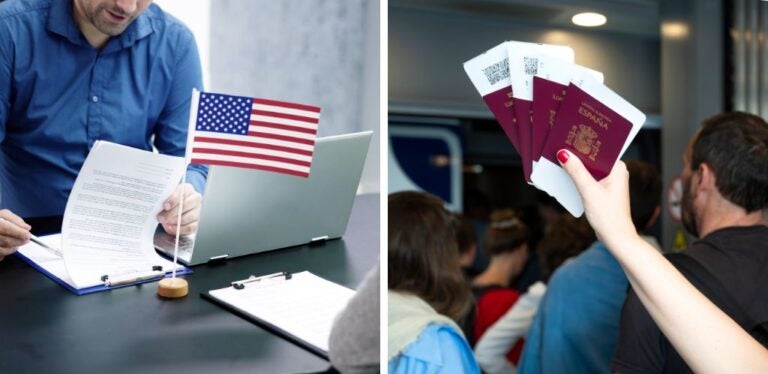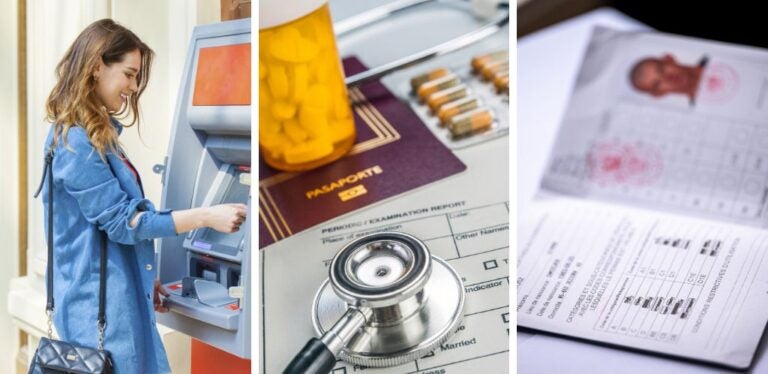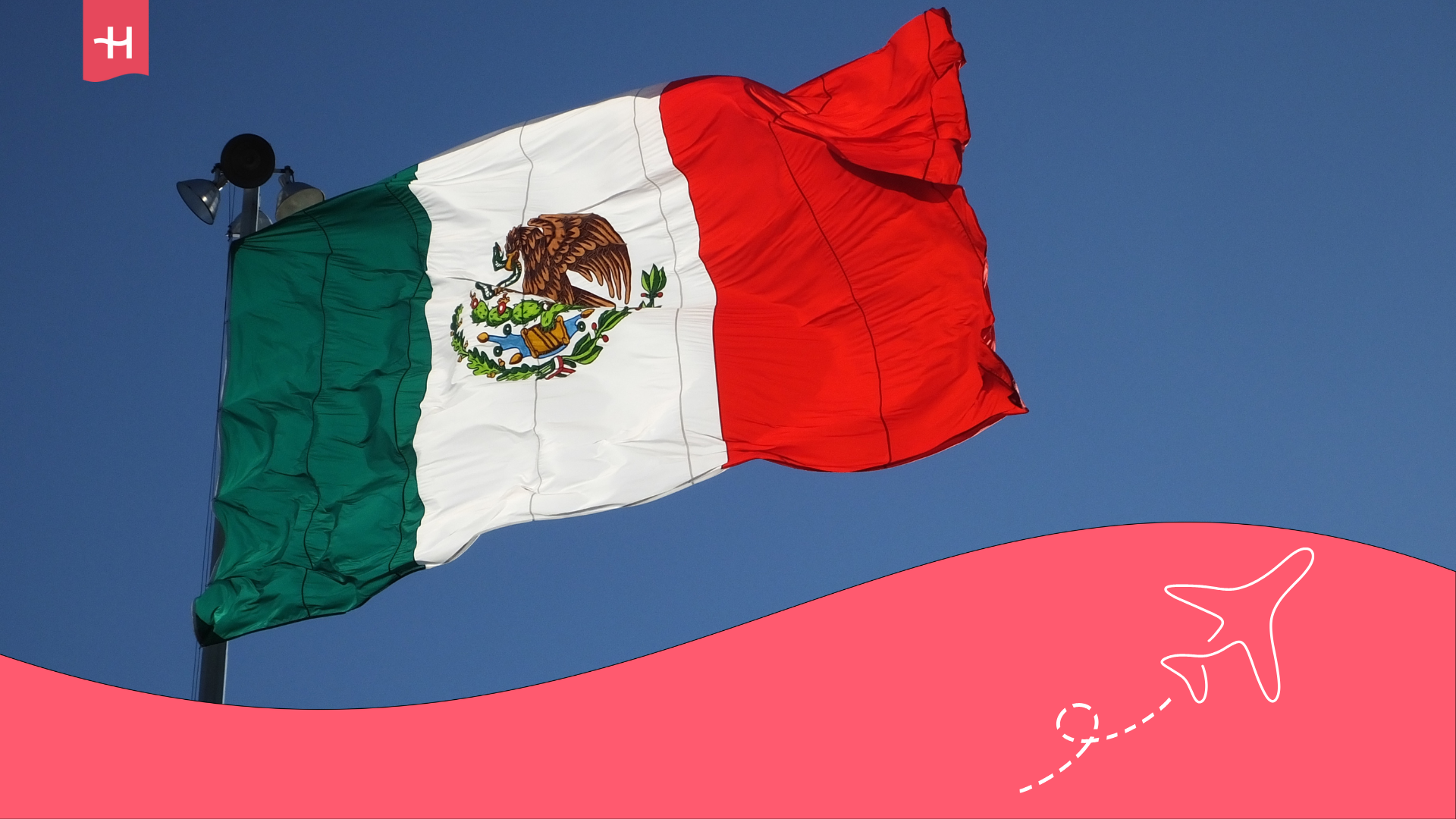Discover the requirements to travel from Spain to USA
Discover the travel requirements from Spain to the USA that you will have to meet in 2025. As well as some tips for your trip!
You might have heard stories about people having trouble getting into the USA. Every day, immigration officers pull aside dozens of travelers due to issues with their paperwork or even because of how they answer certain forms. To help you avoid any setbacks and start enjoying your trip the moment you arrive, we’re here to walk you through everything you need to know about the travel requirements from Spain to the USA.
Before you even book your flight or start packing, there are a few key things you should take care of. We’ll walk you through the essential paperwork, the type of visa you might need based on your trip, any required vaccinations, and whether health insurance is necessary. Plus, we’ll share some extra tips to make sure everything goes smoothly. Ready to get fully prepared for your trip? Let’s dive in!
Tips for traveling to the United States

Before we dive into the travel requirements from Spain to the USA, we want to share a quick tip. While it’s not mandatory, having a reliable internet connection can make your trip much smoother. Being able to access maps, check reservations, and stay in touch easily will make a big difference in your overall experience.
If you’re taking a short trip, the Holafly eSIM for the USA is a hassle-free and affordable choice. You can opt for an unlimited data plan to stay connected without limits or pick a plan based on the length of your stay.
If you’re planning an extended stay then it’s worth looking into Connect’s global internet plans, which offer flexibility and reliable coverage. You can choose from 10GB, 25GB, or unlimited data, and you’re free to switch or cancel anytime based on your usage. Plus, with the 25GB and unlimited options, you can share your connection across multiple devices by enabling the “Hotspot” feature in your settings.
Both options are super easy to set up—you can even do it before you leave for the U.S.! Just follow the instructions after purchasing, and you’ll be connected in minutes.
That said, let’s talk about the travel requirements from Spain to the USA.
1. Flight ticket to the United States and back to Spain
Having a confirmed reservation that proves your intention to return to Spain is essential to pass immigration control once you arrive.
Immigration officials usually request this document to make sure you don’t plan to stay in the USA beyond the allowed time. This is especially important if you’re traveling with an ESTA or a B1/B2 tourist visa, which limits your stay to 90 days. If you’re in the USA for work or study on a specific visa, you’ll need to provide extra documentation to support your longer stay.
How to make sure you meet this requirement?
- Accessible reservation: Carry a digital or printed copy of your tickets with you. Make sure you have it ready to show when you arrive at the immigration checkpoint.
- Consistent dates: Make sure your return flight dates align with the duration allowed by your visa or authorization. For example, if you’re traveling with an ESTA, your return tickets should be within the 90-day limit.
- Flexibility in reservations: Consider purchasing tickets with flexible changes. This can be useful if you have to modify your itinerary due to unforeseen circumstances.
Fulfilling this requirement is not just a must, but also a way to avoid any delays or complications when you arrive in the USA. As a helpful tip, organize your travel plans ahead of time and make sure you have all the necessary documents so everything goes as smoothly as possible.
2. Tourist, residence or work visas for the USA
One important thing to keep in mind when planning a trip to the USA is ensuring you have the right visa for the purpose and length of your stay. While Spanish citizens can use the Visa Waiver Program for short visits (we’ll explain more about this shortly), if you’re staying longer than 90 days or have specific reasons for your visit, you’ll need to apply for a visa. Here are the most common types:
1. Tourist and Business Visa (B1/B2):
This is one of the most common visas. It’s perfect for trips that involve tourism, business meetings, visiting family, or attending events. With the B1/B2 visa, you can stay in the USA for up to 6 months, although longer stays will need to be justified.
For example, if you’re planning an extended trip to explore the East or West Coast, this visa is your best bet. It’s also a good option for living as a digital nomad in the USA.
2. Student visas (F and M):
If you’re planning to study in the USA as an international student, you’ll need to apply for an F visa (for academic studies) or an M visa (for vocational or technical training). In addition to proving your acceptance into a recognized institution, you’ll also need to prove that you have enough financial support for your stay. To get all the details, take a look at our article on the best student visas for the USA, where we explain the different options, costs, and requirements.
3. Work visas (H, L and O):
Work visas are intended for those who have obtained employment in the United States. Among the most notable options are:
- H-1B: For highly skilled professionals in areas such as technology, medicine or engineering.
- L-1: For internal transfers within a multinational company.
- O-1: For individuals with extraordinary ability in fields such as the arts, sciences or sports.
4. Cultural exchange visa (J):
This visa is for those taking part in academic exchange programs, research, or professional training. It’s perfect for students who have received a scholarship to study in the USA, researchers, or anyone looking to join cultural programs organized by approved institutions.
Getting the right visa can take some time, so it’s important to begin the process early. Once it’s approved, you’ll be one step closer to enjoying all that the USA has in store for you.

3. Spanish passport: one of the travel requirements to travel from Spain to the USA
As you can probably guess, a passport is essential for traveling outside the Schengen Area. Before you start organizing your trip to the USA or even booking your ticket, make sure your passport is up to date.
Your passport must be biometric or electronic, which Spain has complied with for years. This means it contains a chip with your personal information and, in some cases, your fingerprints. It’s also essential that your passport is valid for the entire duration of your stay. If you plan to stay for the full 90 days with an ESTA, or longer with a visa, make sure it won’t expire during that time. While the general rule is that it just needs to be valid for your visit, having a few extra months of validity can help you avoid any unexpected issues.
If you don’t have a biometric passport you can apply for one at any authorized police station in Spain. The process is quick and requires an appointment. Just remember to bring your National Identity Card (DNI) and a recent photo. The fee is around 30 euros ($32) in 2025, and you can pay right there when you apply.
Keep in mind that the rules may differ for minors. If you’re traveling with children, check in advance to see if they need any additional documents or specific permissions to enter the USA.
Important: If you are a frequent traveler and want to stay connected without worrying about expensive roaming or looking for a new SIM at every destination, Holafly’s subscription plans are for you. With a single eSIM, enjoy internet in more than 170 countries for a fixed price and no surprises on your bill. travel without limits and connect easily and securely! 🚀🌍

4. Address of the place of accommodation in the USA
Having a valid address for your stay is another essential requirement for traveling to the USA. You’ll need to provide this information during the ESTA authorization process or your visa interview. It’s also likely that immigration will ask for it when you arrive.
It can be the address of a hotel, a co-living space, a rental like those on Airbnb, or even the home of a friend or family member. The important thing is that you can show you have a place to stay while in the USA. If you’re visiting multiple places, it’s a good idea to have a list of all the addresses to avoid any confusion.
For those traveling for tourism, showing a hotel reservation confirmation is usually enough. However, if you’re visiting for business or studies, providing details about where you’ll be working or studying, can help build trust with immigration officers. For example, if you’ll be staying in a university dorm, make sure to have the necessary documents to prove it.
Lack of a clear address can lead to problems during entry and might even result in being denied entry. To avoid this, make sure to prepare this information in advance, keep copies of your reservations (either printed or digital), and have them easily accessible when you arrive.
5. Pass the U.S. immigration control
Awesome! You’ve got your passport, visa, and proof of accommodation all set. But what next? You’ve probably heard stories about travelers being sent to a small room for questioning, or even about people being turned away and not allowed into the USA at all.
These things happen every day. But as long as you have everything in order, there’s no need to worry. When you reach immigration, a Customs and Border Protection (CBP) officer will check your passport, visa, or ESTA, and ask you about your trip. They’ll likely want to know how long you plan to stay, the reason for your visit, and where you’ll be staying. They might also ask for extra documents, like your return ticket or proof of financial means.
Always answer clearly and confidently, avoiding unnecessary doubts. Be prepared for possible requests for additional information.
Although it’s rare, the officer can deny entry if they feel you don’t meet the necessary requirements. Being well-prepared will make the process much smoother, allowing you to begin your U.S. adventure without any hassle.
6. ESTA: the key to enter the USA without a visa
As we mentioned earlier, thanks to the Visa Waiver Program, Spanish citizens don’t need a visa to travel to the USA — as long as you’re staying for less than 90 days. However, that doesn’t mean you can enter the country without any preparation. For tourism, business, or transit stays, you’ll still need to apply for an ESTA (Electronic System for Travel Authorization).
What is it exactly and how do you get it? The ESTA is an electronic authorization that simplifies entry into the USA for citizens of countries participating in the Visa Waiver Program. It’s fast, easy, and digital, so you don’t need to apply for a traditional visa. You can think of it as an “entry pass” that confirms you meet the basic travel requirements.
Steps to apply for your ESTA
- Make sure you have a valid passport: You should have your passport or an appointment to get one. Just remember, it needs to be electronic or biometric and valid for the entire duration of your stay.
- Complete the online application: Access the official U.S. government website to fill out the form. Please do this at least 72 hours before your flight.
- Pay the appropriate fee: As of today, the ESTA costs $21. Only credit or debit card payment is accepted.
- Wait for confirmation: In most cases, the response is immediate, but it can take up to 72 hours. An email will be sent to you with your authorization if approved.
The ESTA form asks for personal details, passport information, and travel plans. You’ll also need to answer questions about criminal history, contagious diseases, and whether you’ve visited certain countries, like Cuba, since January 2021. Be honest—any discrepancies could cause issues down the line.
What if your ESTA gets denied? While it’s rare, it can happen. If your application is rejected, you won’t be able to board your flight. In that case, you’ll need to apply for a regular visa at the nearest U.S. embassy or consulate. That’s why it’s best to take care of your ESTA ahead of time to avoid any issues.
7. Vaccinations when traveling to the United States

If you’re used to traveling outside of Europe, you might be wondering whether you need any vaccinations for your trip to the USA. The short answer is no. There are no mandatory vaccinations to enter the country. However, as with any international flight, being protected against certain illnesses will give you peace of mind and make you feel more secure.
The best option is to visit an international vaccination center in your city. They will provide guidance based on your destination, your health status, and the activities you plan to do. This visit will ensure your vaccination records are up to date.
Although there are no vaccinations required to enter the United States, the following are recommended:
- MMR (measles, mumps and rubella): Especially if you are traveling with children or plan to visit crowded places.
- Tetanus and diphtheria: Essential if you are going to engage in outdoor activities or explore natural areas.
- Influenza: Especially useful during flu seasons, such as autumn and winter.
- Hepatitis A and B: Advisable if you will be tasting local food or have close contact with many people.
Although rarely requested, carrying your international vaccination card is a smart move, and can be useful in medical emergencies or consultations.
8. Medical insurance when traveling to the United States
Although having health insurance isn’t required to enter the USA, here’s one key piece of advice for anyone traveling there: don’t go without coverage from a trusted insurer. The USA doesn’t have a public healthcare system like other countries, and medical bills can be incredibly expensive. For example, a doctor’s visit can easily cost over $200, and a hospital stay can run into the thousands. A solid insurance plan will protect you from unexpected costs related to accidents, illness, or emergencies.
What should a good health insurance policy cover?
When buying health insurance for foreigners in the USA, make sure it includes:
- Comprehensive medical coverage: At least $100,000 for hospitalization and treatment.
- Emergency assistance: Including medical repatriation and medical evacuation.
- Coverage for specific activities: If you are planning to practice sports or outdoor activities, confirm that the insurance includes them.
If you’re traveling for work or study, you might be required to have one. For instance, even though it’s not a requirement to get a student visa, most educational institutions will ask for proof of insurance.
Other tips for traveling to the United States
That covers the main travel requirements from Spain to USA. However, there are a few more things to think about before you board your flight and begin your adventure in this diverse and exciting country. While these aren’t mandatory and won’t prevent you from passing through immigration, they could make a big difference depending on what you plan to do. So, what else should you consider?

1. Travel insurance for the United States
As we mentioned, medical coverage isn’t required to enter the USA from Spain. However, just like with any other destination, having travel insurance is strongly recommended. In the USA, where medical expenses for something like a broken arm can easily cost more than your entire trip, it’s nearly essential.
What are the benefits of a good travel insurance for the United States?
- Comprehensive medical coverage: Top insurances include assistance for accidents, illnesses or even medical evacuations, with limits that can exceed $500,000.
- Protection against unforeseen events: From lost luggage to flight cancellations, a good insurance policy supports you at every stage of your trip.
- 24/7 assistance: A specialized team will assist you in your language, no matter where you are or what you need.
2. U.S. driver’s license
Are you planning to drive along Route 66? Visit national parks? Or rent a car to get around during your trip? If so, you might be wondering whether you can use your Spanish driver’s license. For stays of less than three months, you’re good to go. While an International Driving Permit (IDP) isn’t mandatory, it’s worth getting one. It can help prevent any problems and make dealing with local authorities smoother.
If you plan to study or work in the U.S. for more than three months and intend to drive, you’ll need to get this permit. You can apply for your international driving permit at your local Traffic Department office by appointment. You’ll need to bring your ID card (DNI) or passport, a copy and the original of your valid driver’s license, a recent passport-sized photo, and pay an administrative fee, which is about $11 in 2025. In most cases, once the process is complete, you’ll receive the permit right away, and it will be valid for one year.
3. Carry cash and compatible cards or open an account in the USA
When traveling from Spain to the USA, it’s important to be ready for both digital and cash payments. While most places accept credit and debit cards, some small shops, taxis, or tips might require cash in dollars. Bringing between $100 and $200 dollars is a smart move for unexpected or smaller expenses. Also, make sure your cards work with international payment systems like Visa or Mastercard, and enable contactless payments, which are commonly used in the USA.
Before your trip, let your bank know about your destination and travel dates to prevent any security blocks when making transactions abroad. It’s also worth checking the fees for currency exchange and ATM withdrawals, as they can differ by bank. Having an extra card, like a Revolut or another popular no-fee option for international use, can offer extra peace of mind in case you lose your main card or face any issues.
If you’re going for work or studies, it might be a good idea to open a local bank account. It will make payments and receiving transfers much simpler. The top banks for foreigners in the USA offer great benefits for expats and make the whole process hassle-free.
Frequently asked questions on travel requirements from Spain to the USA
No, if you’re a Spanish citizen and your trip is for tourism, business, or transit for less than 90 days, you only need to apply for the electronic travel authorization (ESTA). For longer stays or specific purposes like working or studying, you’ll need to apply for the appropriate visa.
The ESTA fee is $21. The approval process is usually quick, and you should receive a response within 72 hours. Be sure to apply at least three days before your flight.
You’ll need a valid passport (biometric or electronic), an approved ESTA, and a return ticket or one to another destination outside of the USA. Additionally, you may be asked to provide the address where you’ll be staying and proof of sufficient funds, such as bank statements.
It isn’t a requirement but it’s highly recommended. The USA doesn’t have a universal public healthcare system, and medical costs can be extremely high. Having comprehensive health insurance can save you thousands of euros in case of an emergency.
It’s a good idea to carry between $100 and $200 for small expenses or emergencies, as most places accept credit or debit cards. Don’t forget to notify your bank before you travel to avoid any issues with your transactions.
If your ESTA application is denied, you won’t be able to travel under the Visa Waiver Program. In that case, you’ll need to apply for a traditional visa at the nearest U.S. embassy or consulate. We recommend applying for the ESTA in advance to avoid any issues.
Currently, there are no mandatory vaccines required to enter the United States. However, it’s a good idea to be up to date on basic vaccines, such as the MMR and tetanus, especially if you’ll be engaging in outdoor activities.
Yes, you can use your Spanish driver’s license in most states for trips under three months. However, it’s a good idea to get an International Driving Permit (IDP) to avoid potential issues and make it easier to communicate with local authorities.





 Language
Language 


















 No results found
No results found








